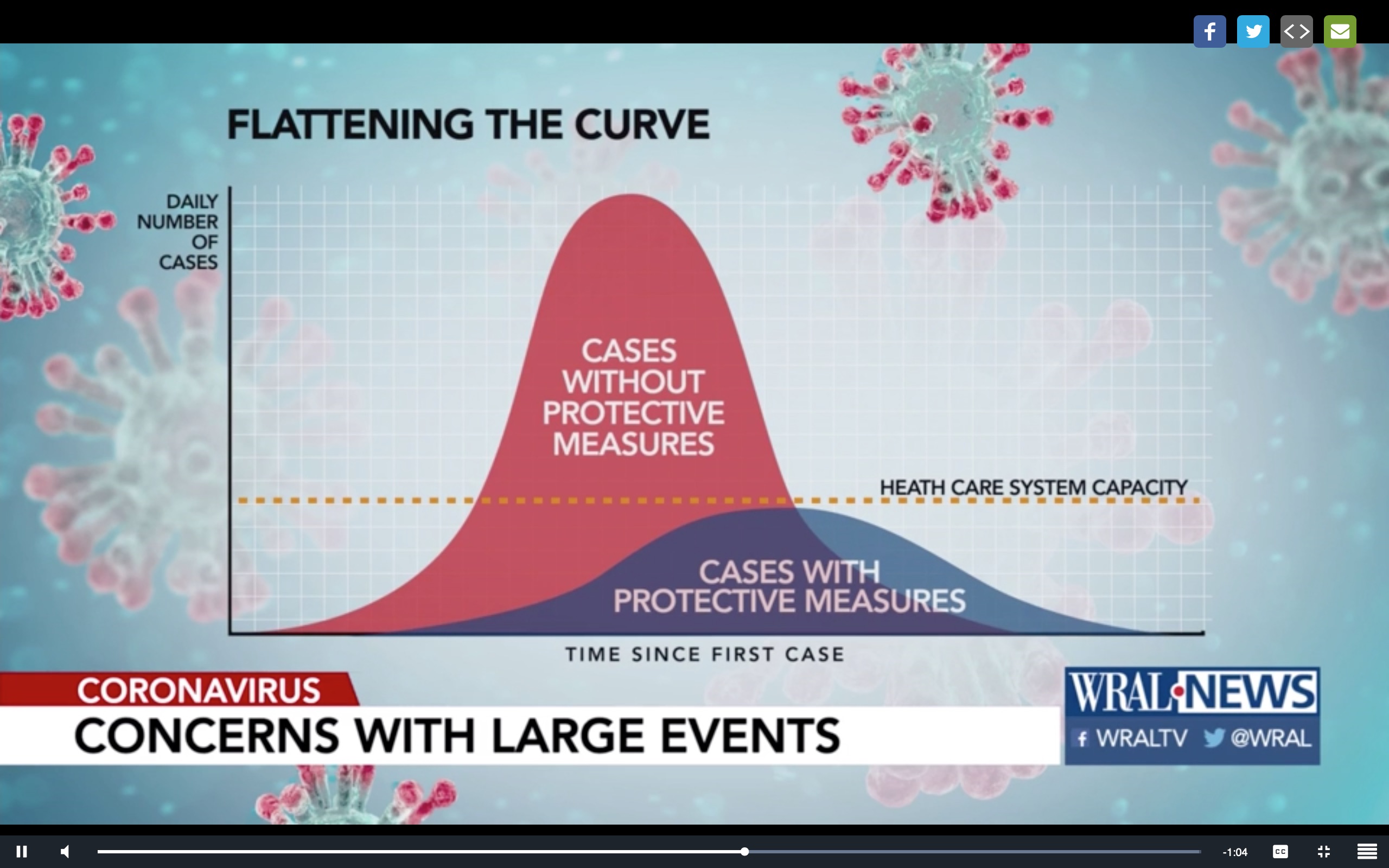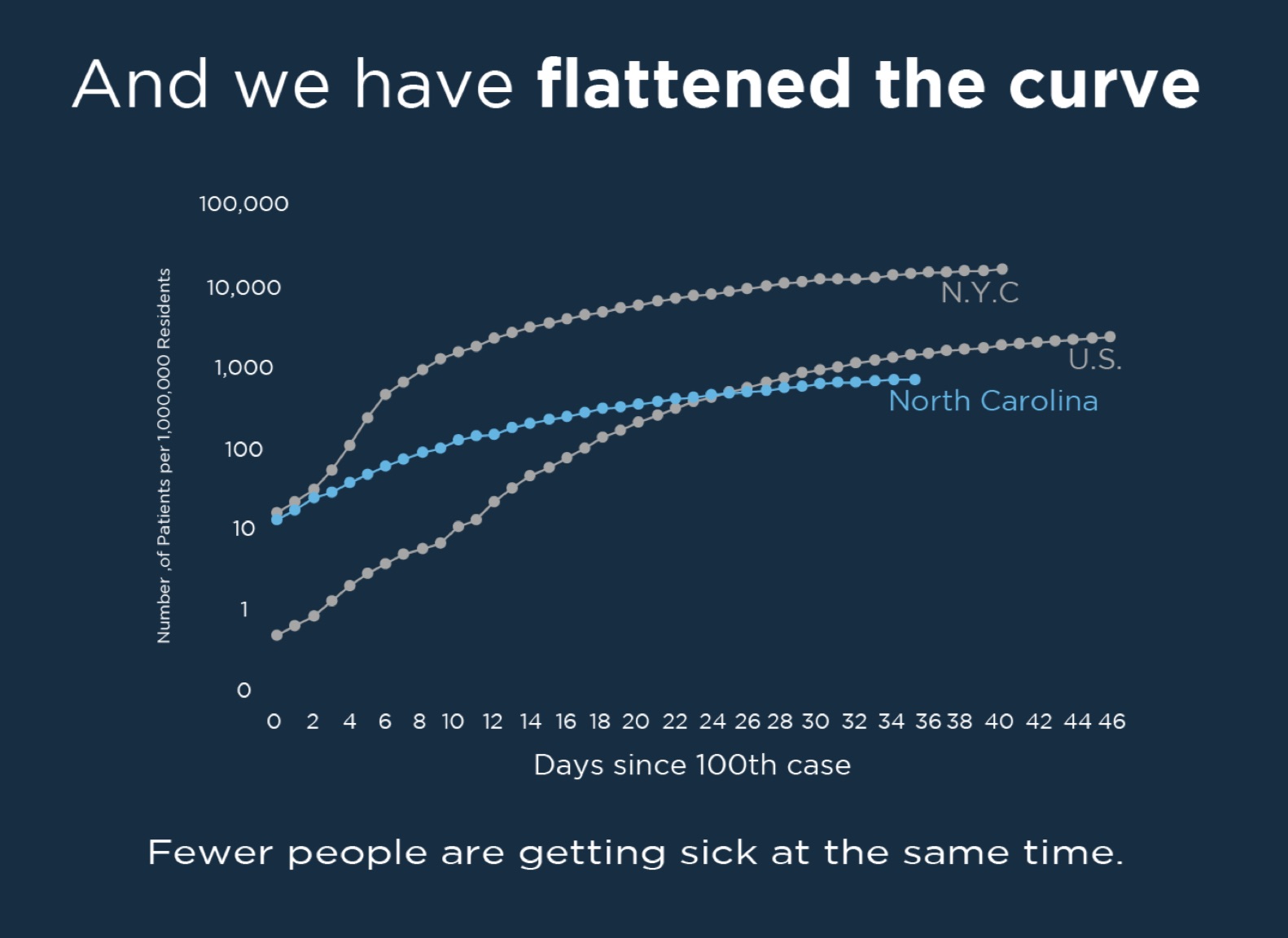It’s important to be in possession of a memory in this extraordinary time. Here are some questions and answers about the founding rationale for our governor’s unprecedented orders closing schools, shutting restaurants and bars and hosts of other “nonessential” businesses, confining people to their homes unless they work in or had business to do with an “essential” business or activity, etc.:
What was the original reason behind Gov. Roy Cooper’s executive orders forcing lockdowns and shutdowns?
Cooper stated it on March 23: “Each and every choice we are making is intended to flatten the curve and provide our health care system the ability to treat the sickest patients in the coming months.”
“Flatten the curve”? I remember a lot of talk about that. What did it mean?
As reported in WRAL on March 26,
While reducing the total number of coronavirus cases is one goal, but it’s not the main goal of flattening the curve.
When health experts talk about flattening the curve, the goal is make sure there are enough resources to keep seriously ill COVID-19 patients alive when the virus hits its peak in North Carolina.
The North Carolina Medical Society, which supports a statewide shelter in place order, is using one prediction of the virus’ impact to make its case. With no protective orders, North Carolina hospitals would be overrun with patients by late April. By social distancing, the number needing medical care will be greatly reduced, but the peak here would push back into May. The medical society says shelter in place would keep the number of patients who need medical care below the number of hospitals beds in our state, with a small peak in July.
Wait. Was “flattening the curve” really about ensuring hospital resources are available for critically ill patients, not about stopping the virus?
Yes. This kind of chart was ubiquitous in March. It’s from WRAL’s March 12 story on cancelling events (such as the ACC Tournament) in order to flatten the curve of the virus outbreak.

Here’s a snippet from the report as it aired:
Reporter: We know that COVID-19 is highly infectious. If no steps are taken to slow it down, the number of cases will increase very quickly. We also know that about one in five people who get it will need medical care and maybe hospitalization. This line [see the chart] is our medical system capacity. It’s not enough to handle all those cases at the same time. That’s what happened in China and Italy.
Jascha Mounk, Johns Hopkins University professor of public policy: That’s the situation with hospitals facing now in Italy. They are resorting to basically choosing which patients lived and which died because they just are not able to help everybody.
Reporter: Flattening the curve means slowing down the spread of the virus to keep it within the capacity of our medical system. That could save tens of thousands of lives.
Well, how long was it going to take to flatten the curve?
Remember that flattening the curve wasn’t about eliminating the virus, but spreading out the COVID-19 cases so that hospitals wouldn’t be overwhelmed.
On March 16, the White House Coronavirus Task Force published guidelines (not orders) called “15 Days to Slow the Spread.” On April 2, the White House Coronavirus Task Force updated the guidelines to “30 Days to Slow the Spread.”
In his March 17 Executive Order shutting down dine-in restaurants and bars, Gov. Cooper cited the White House Coronavirus Task Force’s “15 Days to Slow the Spread.” On March 27, Cooper issued his home lockdown Executive Order and set it to expire by April 29.
So both the governor and the president anticipated flattening the curve to be accomplished toward the end of April to the start of May.
Has North Carolina flattened the curve?
Again, remember what flattening the curve means. It doesn’t mean defeating the virus, eliminating all risk of infection, or finding a vaccine. It means spreading out the infections, lowering the peak of infections so that the highest number of people needing hospitalization stays within hospitals’ capacity to treat them.
And yes, according to the man who issued the orders on the rationale of flattening the curve, North Carolina’s curve has been flattened — for several weeks now.
Cooper announced on April 15 that “Our efforts to flatten the curve are working, and that means we have saved lives.” On April 17 he made the same announcement on his Twitter feed, “North Carolina’s efforts to flatten the curve are working.”
On April 23, weirdly at the same time he announced extending the lockdown and shutdowns beyond — and in some cases far beyond — the original April 29 deadline, Cooper’s slide presentation included this one, titled “And we have flattened the curve.”

Cooper said then, “It’s clear we are flattening the curve, but our state is not ready to lift restrictions yet. We need more time to slow the spread of the virus before we can begin easing those restrictions.”
On May 5, Cooper issued an even weirder statement announcing a tepid “Phase One” plan relaxing a few restrictions: “We have flattened the curve, but we haven’t eliminated COVID-19.” Eliminating the virus was never the intent of imposing all those restrictions on people and businesses.
The Executive Order that Cooper released that day also declared that “since the issuance of executive orders to slow the spread” — note the adoption of the White House Coronavirus Task Force’s language — “of COVID-19, North Carolina has ‘flattened the curve’ and prevented a surge or spike in cases across the state.”
On May 18, Cooper stressed, “Remember, we have flattened the curve, but the threat of COVID-19 is still with us.”
On May 20, Cooper announced a disappointing “Phase Two” plan, relaxing fewer restrictions than he had been promising. Several industries that were expecting to reopen were told they would have to wait at least five more weeks. Nevertheless, Cooper hailed success at flattening the curve and why:
North Carolinians have made changes and sacrifices in their daily lives, and that has helped to flatten the curve here. That means hospitals and medical and the medical system can serve sick patients effectively for all kinds of illnesses, including COVID-19.
Also on May 20, NC Department of Health and Human Services Secretary Mandy Cohen cited success in flattening the curve as justification for keeping restrictions in place longer:
I think you know that we never experienced a surge or a spike in cases. When we don’t have a spike, that means you don’t see a decline. What we have done successfully is to flatten the curve, which means fewer people get sick at the same time. And that’s been very good. And that’s what we want to continue to do. And that’s what I think this modest next step forward in Phase Two will allow us.
On May 28, Cooper again talked about how the state had flattened the curve, but again didn’t relax restrictions further. This time, he appeared to blame hospitals for his not relaxing restrictions.
Originally, hospitals had stopped elective surgeries, preventive care, and other important services in anticipation of the surge of COVID-19 patients, as all the experts, politicians, and media had been warning about. As seen above, of course, that surge never happened, so hospitals returned to treating people again. So the governor returned to warning of a surge again, to justify keeping restrictions tight:
We do know that our hospitals can surge their beds in order to get ready for a surge of COVID- 19. And they did that when, in March, we issued the emergency order, and they got ready for this. Because North Carolinians responded and did what they need to do, we were able to flatten the curve, and that overwhelming surge did not come upon our hospitals.
What they’re doing now is getting back to other kinds of treatments and preventive care and other kinds of surgeries. So there is less room than there was before in the event of a COVID surge.
Recap
- Back in March, Gov. Cooper announced that all his orders restricting people and businesses were “intended to flatten the curve and provide our health care system the ability to treat the sickest patients in the coming months.”
- This rationale was fully in keeping with the well-established understanding of what “flatten the curve” means.
- Since late April, Cooper and Cohen have repeatedly stated that North Carolina has indeed flattened the curve.
So why are gyms, restaurants, bars, salons, bowling alleys, et al. having to sue just to get back into business?


